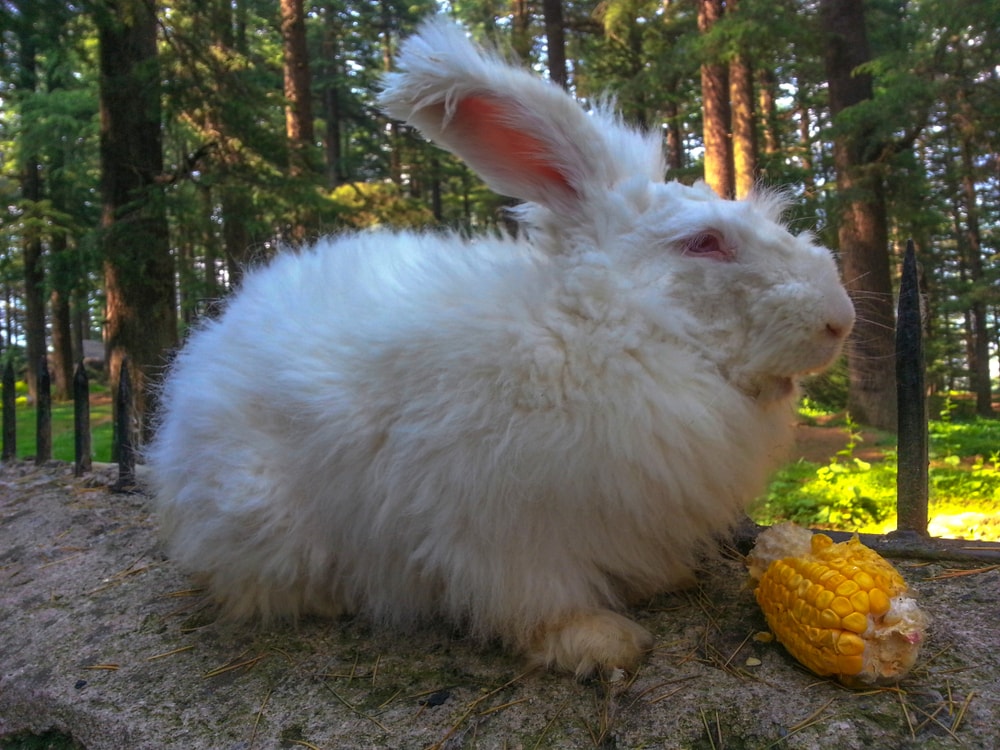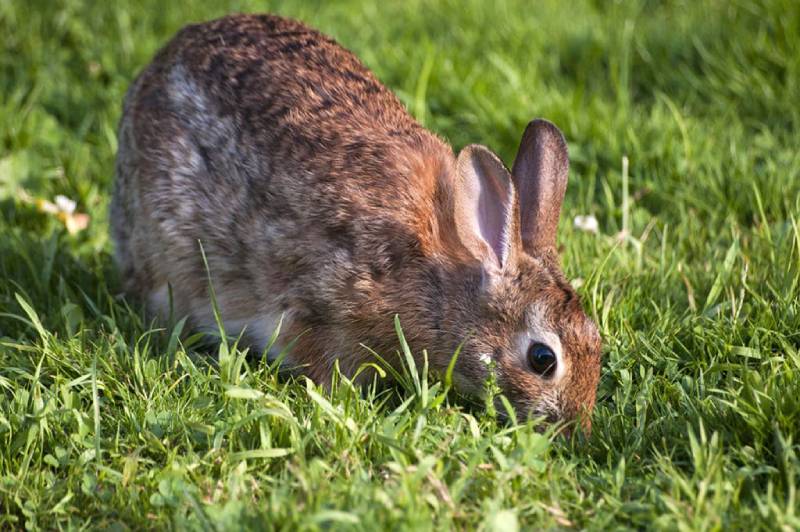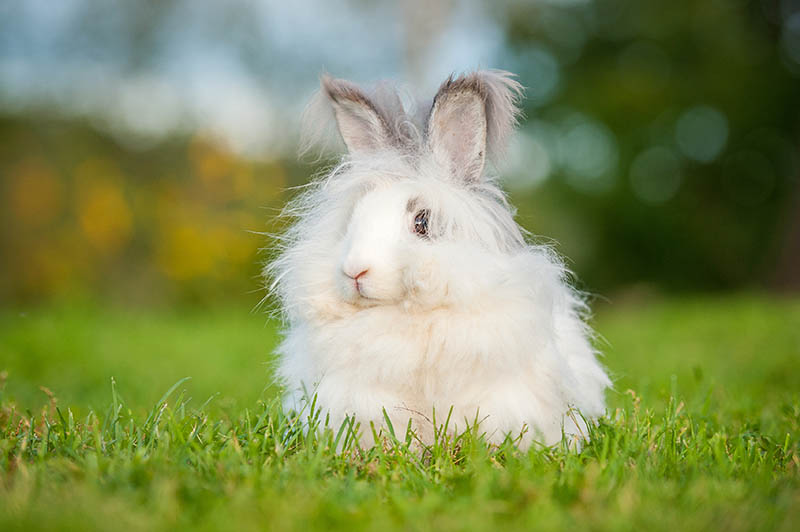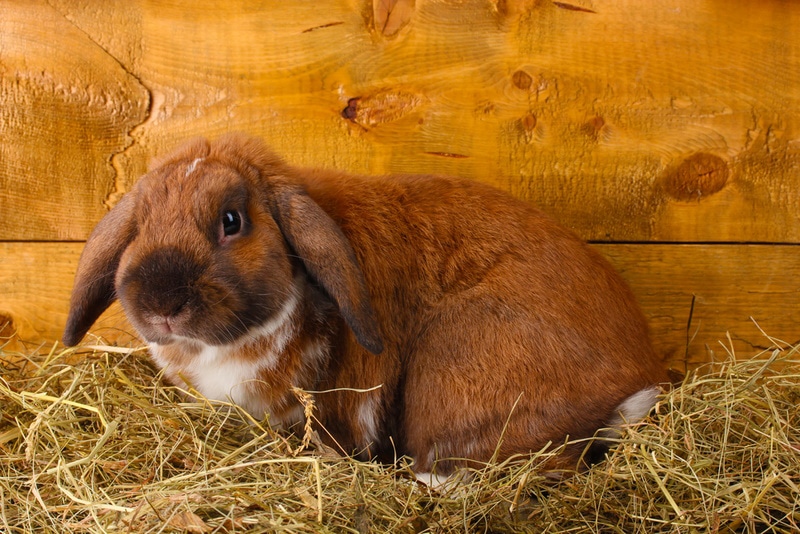Giant Angora Rabbit: Pictures, Care Guide, Lifespan & Traits
By Beth Crane
Updated on

The Giant Angora is a sight to behold; they’re big, blocky, and extravagantly furred. The Giant Angora is the biggest in the Angora breed group and is only found in the stunning “Ruby-Eyed White” color combination. They have long, snow-white fur with three types of hair and are always at least 9 ½ pounds when fully grown. This big bunny breed is special, so read on to find out if they’d make the perfect addition to your family!
| Size: | Giant |
| Weight: | Over 9 lbs, no max weight |
| Lifespan: | 7–11 years |
| Similar Breeds: | French Angora, English Angora, Cashmere Lop |
| Suitable for: | Owners with time to spend grooming, those experienced with long-haired rabbits |
| Temperament: | Gentle, intelligent, friendly |
Giant Angoras are part of the Angora family, which is one of the oldest families of rabbits around. Giant Angoras were bred from smaller Angora breeds (like the French or German Angora) and mated with larger rabbits, such as the Flemish Giant, to produce an Angora of giant size. Angoras originated in Ankara, Turkey (formerly Angora), and were bred for their wool.
They traveled to France in 1723 and made their way across Europe. By the 20th century, the valuable wool Angoras produced was known in the US, and production for the thousands of Angora garments was ramped up after World War II. Today, the wool of the Angora is one of the most expensive textile materials in the world, and Giant Angoras dominate the rabbit show circuits with their smaller Angora cousins.
Giant Angora Breed Characteristics
How Much Do These Rabbits Cost?
Giant Angoras are bred worldwide for their fur and companionship, so finding one shouldn’t be difficult. However, you can expect to pay a pretty price for a true Giant Angora, as they do so well in shows and produce such valuable wool. You can expect to pay between $100 and $300 for pedigreed Angoras, but rabbits bred as pets rather than show animals may be cheaper.
Rabbits bred in family homes are often handled much more than those bred for other reasons, which makes them friendlier and well-adjusted. There is a list of registered Giant Angora breeds on the American Rabbit Breeders Association (ARBA) website, which is a useful resource when checking how many are in your area. Giant Angoras are popular, so you shouldn’t have much trouble finding one!
Temperament & Intelligence of the Giant Angora
Despite their large size, Giant Angoras are docile and friendly thanks to years of domestication. They need a handler confident in maneuvering a rabbit of their stature, but they’re typically gentle and go with the flow! Giant Angoras are intelligent and fun-loving, and they are known to play with toys and bond closely with their human families. They make fantastic pets but need lots of space to accommodate their size.
A large hutch or cage and ample space to hop and jump around is essential to keep these big, fluffy rabbits happy and healthy. Like most rabbits, the Giant Angora can be trained, and they pick up training fairly quickly due to their smarts. Litter training is a little trickier for them because of their copious amounts of hair, but they learn to go in the right place quickly!
Getting the Giant Angora used to grooming from a very young age is essential to their welfare since they cannot efficiently groom themselves and don’t shed their hair. Overheating, painful tangling, and even disease can all occur if you don’t regularly groom your Giant Angora. Familiarizing yourself with their grooming needs and getting them used to the process so it’s as non-stressful as possible is essential.
Do These Rabbits Make Good Pets? 👪
Giant Angoras make great pets for households prepared to deal with their advanced grooming needs. They’re big rabbits with gentle giant personalities, making them suitable pets for older children. They’re charismatic and friendly, and they’ll happily play with other members of the household) if they’re handled frequently from a young age.
The grooming experience can be a great bonding opportunity if approached correctly, and there’s nothing more beautiful than a fully groomed and happy Giant Agora. If you have the space to accommodate them, these rabbits can be an excellent addition to your home. Keep in mind that with a bigger size comes a bigger appetite, so be prepared to spend more on hay and veggies than other breeds!
Does This Rabbit Get Along With Other Pets?
While Giant Angoras are very social with all other rabbits, they need to be well-socialized from a young age to be comfortable with other pets, such as cats and dogs. Rabbits are a prey species, and being around predators like cats and dogs can be very stressful for them if they’re not used to it.
Making sure your other pets know to respect your Giant Angora and their space is also crucial, as some breeds of dog and cat (Greyhounds and Savannah cats, for example) have very high prey drives that will be difficult to overcome. Never leave your Giant Angora alone with other pets, particularly cats and dogs; all it takes is one misinterpreted signal or impulse, and your rabbit could get seriously injured or even killed.
Things to Know When Owning a Giant Angora:
With a rabbit breed as established and special as the Giant Angora, there are certain things you’ll need to know as their owner. Finding out what best to feed them, how to give them a great home, and what tools you’ll need for grooming their fluffy fur are all important, so read on to get clued up on this beautiful breed’s needs.
Food & Diet Requirements 🥕
Giant Angoras need a high-fiber diet in order to survive. Rabbits need to eat a diet of 85-90% grass or hay, as these contain the specific type of fiber that keeps their teeth short and their digestive systems working correctly. Your Giant Angora should have an unlimited supply of high-quality hay, such as Timothy or Orchard hay, to chew throughout the day and night. Alfalfa hay is too high in protein for adult Giant Angoras, so it should only be fed to juveniles and weaned babies.
Dark leafy greens are the second largest part of your Giant Angoras diet; you should feed them a mix of vegetation, making up around 10% of their total diet. A variety of dark greens and healthy veggies are essential for the right vitamin and mineral balance, but any new greens you give your Giant Angora should be introduced slowly to avoid upsetting their digestive systems. A good selection of leafy greens to be fed daily includes:
- Mustard greens
- Watercress
- Basil
- Cilantro
- Curly Kale
- Radish greens
High-quality hay-based rabbit pellets comprise the last portion of your Giant Angoras diet, but they should only be fed around 1/8th of a cup per 5 pounds of body weight. Rabbit pellets don’t provide adequate nutrition or fiber to your rabbit and can cause obesity and gastrointestinal problems, among other things.
Your Giant Angora can occasionally enjoy a treat, but stick to vegetables such as carrot tops (occasionally) or sweet peppers. It’s best to avoid serving commercial rabbit treats since they’re often high in carbohydrates, which your rabbit doesn’t need.
Habitat & Hutch Requirements 🏠
Giant Angoras need lots of space to run around in daily, and they’ll need a large hutch or cage to act as their sleeping area. Your Giant Angora should be able to stand up fully without their ears touching the ceiling, turn around, lay down completely flat without touching any of the walls, and hop at least three to four hops in any direction within their main sleeping area or cage. However, that is the minimum requirement, and you should provide the biggest housing area for your Giant Angora. They should always have fresh hay, water, food, and a litter box in their main living area.
Exercise & Sleeping Needs 🐇
Your Giant Angora will need a secure place to sleep that gets dark at night. Rabbits are crepuscular (meaning they’re more active at dawn and dusk) and sleep for around 8 hours a day. Allowing them to sleep undisturbed in a darkened area they feel safe and secure in (such as their hutch) can reduce stress and prevent stress-related illnesses.
You should allow your Giant Angora to exercise daily in an enclosed, safe space. Because of their size, your Giant Angora will need a large rabbit run. A bunny-proofed room is the best way to provide them with it if you don’t have outdoor space, and your Giant Angora can run and jump about to their heart’s content. Remove any wires, sharp corners, and unstable surfaces your rabbit could get to in their room, and make sure the flooring is chew-proof and slip-proof. The room should be completely secure, and other pets shouldn’t have access to it.
An outdoor run is also a very good idea, but it needs to be large to allow your Giant Angora to exercise. Security is the number one concern with outdoor runs, as rabbits are excellent diggers and can dig under runs! Runs can also be interconnected with secure tubes and different passages to give your Giant Angora an enriching experience.
Training 🥎
Giant Angoras can be trained like other bunnies, and they’ll enjoy the time with you! Training can be done with healthy treats and lots of encouragement and can be as simple as teaching your giant Angora to use a litter box. Basic training should include becoming comfortable with handling and grooming, sitting still for nail clips, and being comfortable with traveling in a cage (to go to the vet).
Training your Giant Angora to be comfortable with grooming is probably the most important training you’ll need since they need thorough grooming to be healthy and happy. You can also train your rabbit for fun, and many Giant Angoras are intelligent enough to perform tricks or play games with you (like fetch!).
Grooming ✂️
Giant Angoras have very long under and overcoats, which never stop growing and do not shed. Pair that with the breed’s inability to groom itself sufficiently due to all its hair, and you have a bunny that needs constant grooming and upkeep. A healthy Giant Angoras fur can grow up to 1.2 inches per month! They’ll need daily brushing with a brush and comb to keep them comfortable and tangle-free. You’ll need to clip your rabbit’s fur every three months or so. Leaving the hair long can cause matting which causes pain and sores on the skin. Giant Angoras are prone to fly strike (myiasis) because of the possibility of these skin lesions, so make sure you’re prepared to groom them thoroughly every day to keep them healthy.
Lifespan and Health Conditions 🏥
The Giant Angora lives for an average amount of time for a pet rabbit, and most can live past 10 years if they’re well looked after. Because of their size and coat, the Giant Angora have some health conditions you should be on the lookout for:
- Obesity
- Dental Disease
- Pododermatitis
- Hair matting and skin disease
- Fly strike
- Gastric stasis with bloat
- Decreased gut motility
Male vs Female
Male Giant Angoras typically weigh more than females (around 1 pound more) and have longer hair on their ears and necks. Female Giant Angoras can grow bigger dewlaps (fat and skin sitting below the neck) than males, but males can also grow them!
3 Little-Known Facts About Giant Angoras
1. They Come in Other Colors
Hobby breeders of the Giant Angora have introduced different colors into the breed for variation from the standard ruby-eyes white. All-black Giant Angoras are proving popular, but ARBA accepts no colors other than ruby-eyed white.
2. They Can Be Tricky to Handle
Because of their large size, the Giant Angora needs very careful handling. Rabbits don’t like being lifted off the ground, and some can struggle, leading to potential injuries for both the rabbit and the handler! Giant Angoras have large and powerful hind legs and feet, which can inflict harsh scratching injuries, and a struggling rabbit of that size can cause serious damage. It’s best to avoid lifting them and always keep them low to the ground.
3. Their Fur Is Worth Big Bucks
The Angora’s plentiful fur can sell for as much as $16 per ounce, and each Giant Angora can produce up to 40 ounces a year. If the wool is spun and processed, the price is increased dramatically! Angora rabbit fur is one of the most expensive natural textiles in the world, but controversy surrounds the unethical plucking of these bunnies in large-scale fur farms.
Final Thoughts
The Giant Angora is a friendly rabbit in a big and fluffy package. Despite being giants, they’re calm and gentle and are very suitable as family pets. Giant Angora owners need to be prepared to groom them daily and keep on top of their coats. They can’t groom or shed it themselves and must be plucked or sheared once every 90 days. If you can find the time, the grooming process with a Giant Angora can be relaxing and a time to bond with them. Giant Angoras make wonderful pets, but the upkeep and space they require make them more suitable for those used to dealing with furry, large-breed bunnies.
Featured Image Credit to: BRAVO-2626, Shutterstock













